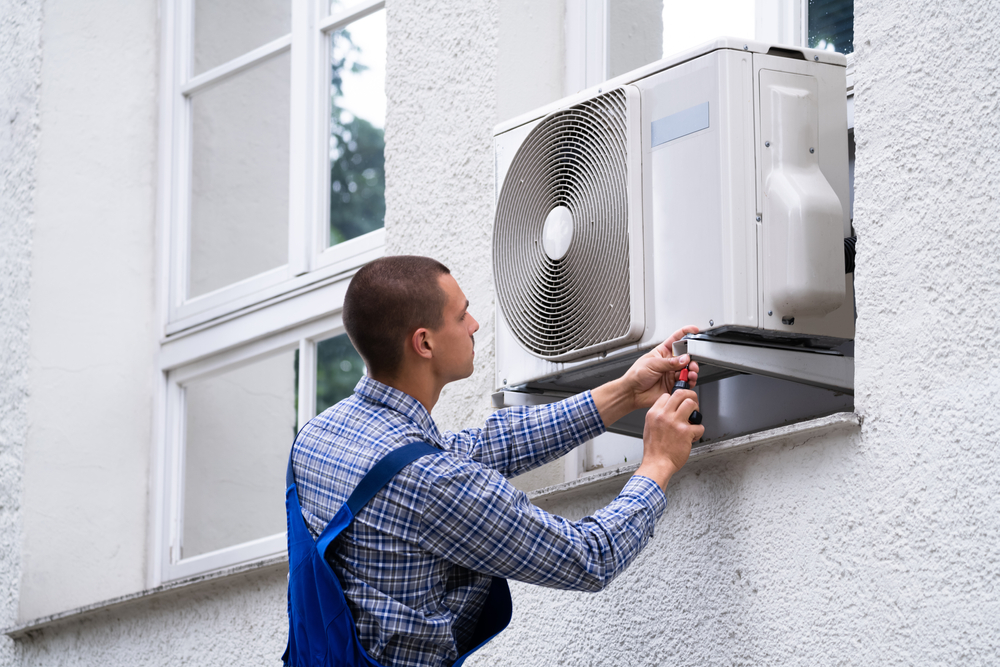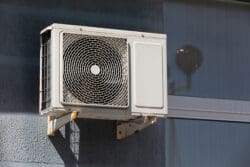
Ductless mini-split systems have quickly become a go-to HVAC solution for Florida homeowners seeking energy efficiency, targeted comfort, and easy installation. But while these systems offer serious flexibility, their performance depends heavily on one key factor: placement.
Where you install the indoor and outdoor components of a mini split can significantly impact airflow, temperature control, energy usage, and even the lifespan of your system.
In this guide, we’ll walk through the best place to install a mini-split and where NOT to install it. Plus, read on for some expert-backed mini-split tips from the experienced team at Gulf Shore Cooling, LLC.
Why Mini-Split Placement Matters
When properly installed, mini-splits are highly efficient. A poorly placed indoor unit, however, can cause hot or cold spots, block airflow, or even cause the system to short-cycle. Outdoors, improper placement can expose your condenser to excess heat, airflow blockages, or service complications.
Here’s why proper mini-split placement matters:
- Maximizes airflow and coverage
- Improves temperature consistency
- Reduces energy bills
- Extends equipment lifespan
- Minimizes unnecessary maintenance
Whether you’re upgrading a single room or outfitting an entire home, smart placement is the difference between comfort and frustration.
Best Indoor Placement for Mini-Split Air Handlers
Where you install the indoor air handler directly affects airflow and room comfort. Every room has its unique quirks, and your HVAC technician will consider factors such as ceiling height, room usage, insulation, and furniture layout when helping you select an ideal indoor mini-split location.
High on the Wall, Away from Obstructions
Installing the air handler high on the wall ensures that cool or warm air naturally circulates downward. Keeping it away from drapes, furniture, or shelves prevents airflow blockages and avoids inefficient operation. Avoid cramming units into tight corners or recessed spaces, as this can cause short cycling and uneven coverage.
Central Location Within the Room
A central placement helps maintain consistent room temperatures and improves energy efficiency. It reduces the need for the unit to “overwork” in one direction, which can happen if it’s tucked away in a corner. This position also allows for better airflow distribution across larger or irregularly shaped rooms.
Rooms With High Heat Load
Rooms that receive direct sunlight or contain lots of electronics (like kitchens or game rooms) can benefit from a well-placed mini split. Installing the unit where it can offset heat load—without being directly above the source—will increase comfort and reduce energy use.
Open-Concept Living Spaces
In open-concept layouts, choose a location that allows air to reach the farthest corners. High and centered on a main wall, ideally between two zones (like kitchen and living room), gives the best balance. Pair this with ceiling fans to assist in air circulation without direct interference.
Bedrooms
Quiet operation and direct airflow control are key in bedrooms. Avoid placing units right above the bed. Instead, mount them higher on a side wall, so air flows across the room rather than down on sleepers. This also prevents nighttime temperature swings and discomfort caused by direct airflow.
Home Offices
Home offices often have computers and electronics that generate heat. Place the mini split high, centrally located, and not directly aimed at your desk or monitors to prevent cold spots or air blasts during long workdays.
Worst Indoor Mini-Split Placement Locations to Avoid
Placing a mini-split in the wrong location can result in poor performance, discomfort, and increased maintenance requirements. Now that we’ve reviewed ideal mini-split placement practices, where should you not install a mini-split?
Near Heat Sources (Ovens, Electronics)
Placing a mini split too close to heat-producing appliances—like ovens, stovetops, or media centers—can confuse the unit’s temperature sensors. The system may work harder than needed, leading to higher energy use and uneven cooling. Proximity to heat sources can also reduce the lifespan of internal components.
Behind Furniture or Curtains
Blocking the air handler with tall furniture, curtains, or wall art limits airflow and causes stratified temperatures, where part of the room stays too warm while the rest is chilly. Always leave ample clearance around the unit, especially below and on the sides, to maintain proper circulation.
Above Doors or Windows
Many homeowners assume above-door placement saves space. However, this location often leads to air leaks from opening and closing the door or window, which disrupts airflow and increases wear on the system. It can also lead to short cycling, which shortens system lifespan and wastes energy.
Near Ceiling Fans or Supply Vents
Never place your mini split near an active ceiling fan or a forced-air HVAC vent. Competing airflow patterns can interfere with the mini split’s sensors, leading to inefficient heating or cooling. Worse, it can cause the system to run longer than needed, increasing your utility bill.

Ideal Outdoor Placement for the Condenser Unit
The outdoor condenser is the heart of your mini split system, and its location affects everything from energy use to noise and long-term serviceability. Here are the factors to consider when choosing the best place to install a mini-split condenser unit:
On a Level, Elevated Platform
A level and stable base—such as a concrete pad or wall bracket—is essential. This keeps the condenser aligned for proper refrigerant flow and reduces vibration. If flooding or heavy rains are common in your area (like Southwest Florida), elevating the unit avoids water damage and corrosion.
In a Shaded, Well-Ventilated Area
Installing your condenser in partial shade protects it from overheating in direct sunlight. At the same time, good ventilation allows heat to dissipate quickly, keeping the system efficient. A shady spot with a breeze is ideal—just avoid enclosing the unit with fencing or bushes.
Near the Room It’s Cooling (Shorter Line Run)
The closer the condenser is to the indoor unit, the shorter the refrigerant line, which improves system efficiency and reduces the chance of leaks. For multi-zone systems, aim to place the condenser centrally relative to all indoor units to minimize the total line length.
Accessible for Service and Maintenance
Don’t hide the condenser behind sheds or tight landscaping. Make sure HVAC professionals have easy access to the unit for inspections, cleanings, and repairs.
Outdoor Placement Mistakes to Avoid
Avoiding these common outdoor mini-split placement mistakes can help you reduce noise complaints, service costs, and energy waste.
Direct Sunlight Exposure All Day
Constant exposure to full sun raises the internal temperature of the condenser, forcing it to work harder to reject heat. Over time, this leads to system strain and higher utility bills. Use landscaping, awnings, or building shade to provide protection without blocking airflow.
Areas With Poor Airflow
Condensers need room to breathe. Tight alcoves, fences, or walls that surround the unit can trap heat, making your system less efficient. Always follow manufacturer clearance guidelines when choosing your mini-split location—typically at least 12–24 inches on all sides.
Under Decks or Tight Overhangs
While shade is good, placing the unit directly under a low deck or overhang restricts upward airflow and can lead to overheating. Choose a location where hot air from the condenser can rise freely and disperse.
Too Close to Neighbors or Bedrooms (Noise Concerns)
Although mini splits are quiet, the outdoor unit still generates some sound. Avoid placing the condenser right next to bedroom windows or neighboring property lines, especially in zero-lot-line homes. Positioning it farther from living and sleeping areas ensures a more peaceful environment indoors and out.
Placement Tips for Multi-Zone Mini-Split Systems
Multi-zone mini splits are a great option when you need customized comfort in multiple rooms. But planning where to place each air handler—and how they relate to the outdoor condenser—requires extra strategy.
Balance Between Rooms for Even Cooling
Don’t place multiple air handlers too close together. Instead, space them across the home to create balanced cooling and reduce overlap. Each unit should serve a clearly defined zone without competing with its neighbor.
Don’t Overload One Side of the Home
If all your units are concentrated on one end of the house, it can cause uneven temperature control. You’ll also risk longer refrigerant lines for distant rooms, which may impact performance.
A good layout distributes air handlers based on sun exposure, use patterns, and room size.
Use Dedicated Zones for High-Use Areas
High-traffic zones like kitchens, living rooms, and bedrooms should each have dedicated air handlers. Don’t try to “share” a unit between a busy room and a hallway—it reduces comfort and causes the system to cycle more often.
Dedicated zones also allow for temperature control by area, improving energy efficiency.
Maintain Refrigerant Line Length Guidelines
Every manufacturer sets a maximum refrigerant line length, and exceeding it can lead to refrigerant charge issues and a loss of cooling efficiency. Keep indoor units as close as possible to the condenser, and avoid unnecessary bends or elevation changes.
How HVAC Professionals Determine the Best Placement
Proper mini-split placement isn’t just about what looks good—it’s a technical process.
HVAC professionals use load calculations to understand the cooling and heating needs of each space. They’ll evaluate:
- Room size and layout
- Ceiling height
- Insulation and sun exposure
- BTU sizing requirements
- Window location and type
- Existing airflow patterns
These assessments help technicians place each unit where it can operate efficiently and last longer, while minimizing hot/cold zones.
Partner with Gulf Shore Cooling, LLC to ensure your system complements your home and isn’t just installed “where it fits.”
Can You Install a Mini-Split Yourself?
DIY installation of mini splits is growing in popularity thanks to video tutorials and pre-charged kits. But when it comes to placement and performance, professional installation is still strongly recommended.
Here’s why:
- EPA regulations require certified technicians to handle refrigerant
- Improper placement can cause system failure, void your warranty, or lower efficiency
- Pros ensure correct line length, slope, electrical hookups, and drainage
- Installers optimize placement for aesthetics and performance
For a system that lasts, runs quietly, and performs year-round, leave the install to the pros.
Why Call Gulf Shore Cooling for Expert Mini-Split Installation
With decades of experience serving Southwest Florida, our experienced team at Gulf Shore Cooling, LLC understands the region’s climate and housing types.
We help homeowners choose the right system and install it with precision and efficiency. Whether it’s a single-zone bedroom unit or a full-home multi-zone setup, we will provide expert guidance when choosing the best place to install your mini-split.
We also offer fast service, honest pricing, and professional support from certified techs.
Contact Gulf Shore Cooling for Mini-Split Installation Today
Choosing where to install your mini split can make or break your investment. If you’re unsure about placement or want peace of mind knowing your system is installed right the first time, we’re here to help.
Contact us today to schedule a consultation or explore our AC services in Fort Myers and surrounding communities. Gulf Shore Cooling has the tools, talent, and local experience to deliver year-round comfort.
Mini-Split Placement FAQ
1) Can a mini split cool more than one room?
Yes, if it’s a multi-zone system, one condenser can power multiple indoor air handlers in different rooms. Each zone gets individual temperature control and energy-efficient comfort.
2) Are there ceiling-mounted mini-split options?
Yes—some systems offer ceiling cassette-style indoor units, ideal for rooms where wall space is limited. These work best in larger spaces with high ceilings.
3) How loud is a mini-split indoor unit?
Most mini splits operate around 20–30 decibels indoors, which is quieter than a whisper. Outdoor condensers are also very quiet, especially compared to traditional AC systems.
4) What’s the minimum clearance around the outdoor condenser?
Most manufacturers recommend at least 12–24 inches of clearance on all sides and 5 feet above. This ensures proper airflow and safe maintenance access.
5) Can a mini-split go above a bed or a couch?
It can, but it’s not ideal. Direct airflow can cause discomfort while sleeping or sitting. Install the unit higher and slightly offset from the furniture for best results.
6) Do mini-splits work well in basements or attics?
Yes, as long as the space is insulated and the system is sized correctly. Placement in tight or hot spaces, such as attics, may require additional ventilation or dehumidification.



